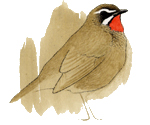DB 28 (2) 2006
Published by Abdullah F Alfadhel. E-mail info@kuwaitbirds.
com, website www.kuwaitbirds.com. 304 pp.
ISBN 99906-76-77-1. GBP 29.95.

Kuwait is situated in the extreme south-eastern corner
of the Western Palearctic region as defined by 'BWP'.
At the same time, it forms the north-eastern corner of
the Arabian Peninsula. The avifauna is predominantly
Palearctic, although a few species with a mainly oriental
or Arabian origin occur as breeding birds, on passage
or as vagrants. The country's bird list holds c 380
species, some of which are hard or almost impossible
to see elsewhere in the WP (but are often easily found
in other Arabian countries). These include Socotra
Cormorant Phalacrocorax nigrogularis, Shikra Accipiter
badius, Crab Plover Dromas ardeola (the population on
Bubiyan island probably being the largest in the world),
Lesser Sand Plover Charadrius mongolus, Red-wattled
Lapwing Vanellus indicus, Great Knot Calidris tenuirostris,
Saunders's Tern Sternula saundersi, Indian
Roller Coracias benghalensis, Eversmann's Redstart
Phoenicurus erythronotus, Grey Hypocolius Hypocolius
ampelinus and Basra Reed Warbler Acrocephalus
griseldis. Year-round species with an 'oriental' touch
include White-cheeked Bulbul Pycnonotus leucotis,
Red-vented Bulbul P cafer, Bank Mynah Acridotheres
ginginianus, Common Mynah A tristis (all four common
breeders) and Indian Silverbill Euodice malabarica but,
probably apart from White-cheeked Bulbul, these are
all of feral origin. From an 'peninsular' point of view,
Kuwait holds several breeding species that are rare or
absent elsewhere in the Arabian Peninsula.
This book presents more than 400 colour photographs
of birds, all taken in Kuwait by the author.
Almost all are of good quality and several are excellent,
including some remarkable close-ups. However,
not to everyone's (at least my) liking will be the heavy
cropping of several photographs, resulting in birds with
tails or other feather parts being 'lost'. The photographs
include some of the specialities mentioned above - but
not all. The text accompanying the photographs is in
Arabic but English and scientific bird names are added.
The source for the English and scientific names is not
mentioned but the treatment is generally up to date as
far as taxonomy and nomenclature are concerned. For
instance, Greater Flamingo is named Phoenicopterus
roseus, 'Red-tailed Wheatear' Oenanthe chrysopygia/
xanthoprymna is treated as two species (although the
name 'Kurdish Wheatear' for O xanthoprymna is
curious as Persian Wheatear is the most commonly
proposed new name), Basra Reed Warbler is treated as
a full species and the same holds for Desert (Lesser)
Whitethroat Sylvia (curruca) minula. The English text
holds a few errors or curiosities. For example, Eastern
Orphean Warbler should be S crassirostris (not S jerdoni),
Black Bush Robin should be Cercotrichas podobe
(not C podobes) and Sykes's Warbler A rama is
incorrectly spelt as Syke's Warbler. From a taxonomic
point of view, the naming of 'Red-wattled Plover' (Redwattled
Lapwing) as Hoplopterus indicus and 'Sociable
Plover' (Sociable Lapwing V gregarius) as Chettusia
gregaria seem outdated, especially when, at the same
time, 'Spur-winged Plover' (Spur-winged Lapwing)
V spinosus is included in Vanellus. Also remarkable is
the naming of Rock Martin Ptyonoprogne fuligula as
Hirundo fuligula, whereas the closely related Crag
Martin P rupestris is included in Ptyonoprogne.
The book includes a chapter describing the 34 best
birdwatching sites in Kuwait and an introduction to the
Kuwaiti environment with a brief overview of the conservation
efforts undertaken towards the protection of
birds. Although not a prime destination for birders, this
small country (17 800 km2, about half the surface area
of the Netherlands) has good birding on offer and has a
strategic position to add new species to the WP list (as
defined by BWP). In fact, according to the text, the
country already has records of some extreme WP rarities,
such as Sacred Ibis Threskiornis aethiopicus (a
long-staying bird in 1981-92), Chestnut-bellied Sandgrouse
Pterocles exustus and Oriental Reed Warbler
A orientalis (photographed on 20 April 2004; see
http://birdsofkuwait.com/Birds/birds_of_kuwait.htm), although
the first and latter species are not mentioned in
the bird list. ENNO B EBELS



